The famous festivals in Gujarat are a symphony of vibrant colors, spirited dances, and rich traditions that embody the state’s cultural splendor. Visitors are mesmerized by the array of celebrations from the rhythmic Garba dances of Navratri to the high-flying kites of Uttarayan, marking Gujarat as a treasure trove of jubilant festivities.
An Introduction to Gujarat’s Vibrant Festival Heritage
The Cultural Essence of Gujarat’s Festivals
Gujarat, a beacon of Gujarat Tourism, encapsulates a rich tapestry of culture that comes alive during its numerous festivals. Renowned for their exuberance and cultural depth, these events are not just a celebration of life, tradition, and unity, they are a vibrant showcase of the enthusiasm and zeal that characterize Gujarat as an alluring travel destination. With every festival, the state dons a palette of colors and sounds, inviting not just locals but travelers from around the globe to partake in its heritage, thereby bolstering tourism and the communal spirit.
What Makes These Celebrations a Must-See?
These festivals are a spectacle of vivid colors, energetic dances, soul-stirring music, and sumptuous feasts. They showcase Gujarat’s unique customs and artistic traditions. The state, during such times, transforms into a massive stage that exhibits the folklore and the collective spirit of its people, weaving together communities regardless of their backgrounds. For visitors, it’s a rare chance to witness the harmony of ancient customs with the contemporary zest of celebration, making them an unforgettable part of any trip to India.
Key Highlights of Festivals in Gujarat
| Element | Description |
| Cultural Richness | Experience centuries-old traditions coming to life in vibrant and colorful ways. |
| Diversity in Celebration | Each festival offers a unique celebration, from kite flying to desert festivals and classical dance performances. |
| Hospitality | Gujarati hospitality reaches its peak during festivals, providing an intimate look into the heartwarming culture. |
| Gastronomic Delights | Relish the culinary diversity with a variety of traditional Gujarati dishes that become the highlight of celebrations. |
| Artisanal Craftsmanship | Festivals feature fairs showcasing exquisite local handicrafts, textiles, and jewelry, highlighting artisanal craftsmanship. |
Unique Festivals in Gujarat
1. International Kite Festival (Uttarayan)

The International Kite Festival, known locally as Uttarayan, is not just a festival but an emotion that blankets the skies with millions of kites and binds participants in an aerial symphony. Held annually on January 14th to celebrate the transition from winter to summer, it marks an auspicious period for farmers heralding the coming of the harvest season. As one of the main festivals of Gujarat, it becomes a playground for the international kite festival Gujarat where the sky becomes a canvas for a splendid array of kites.
This festival attracts kite enthusiasts from across the globe, turning the sky into a mosaic of intricate designs and vibrant hues. The kite competition is particularly fierce, as locals and international visitors go head-to-head in friendly rivalry, with each participant trying to outdo the other in skill and creativity. Enthusiasts and spectators revel alike in this cultural phenomenon that reflects the spirit of joy and competition innate to the Gujarati people, making it much more than a simple beach festival.
- When International Kite Festival is Celebrated: January 14th or 15th annually
- Location: Ahmedabad, Gujarat
- Best for: Kite enthusiasts, photographers, culture explorers
2. Modhera Dance Festival
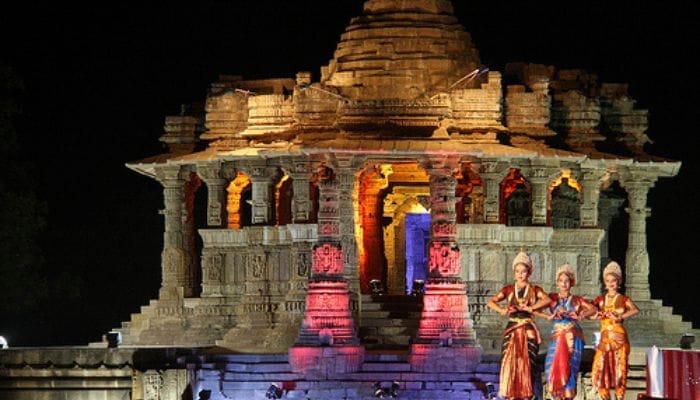 Image Source
Image SourceThe Modhera Dance Festival, a renowned cultural event closely followed by the vibrant beach festival season, springs to life against the stunning architecture of the Modhera Sun Temple every third week of January. This festival is an embodiment of Gujarat’s dedication to preserving and celebrating its classical dance forms, just as the beach festival of Gujarat underlines the state’s festive coastal spirit between November and December. Professional dancers grace the stage, adorned in elaborate traditional costumes, and their performances exude devotion, narrating stories through intricate moves and rhythms.
As the sun dips below the horizon, the temple’s sandstone structures glow, creating a mesmerizing setting that transports audiences back to the golden age of Indian cultural history, much like the illuminated Tithal Beach during the annual beach festival.
- When Modhera Dance Festival is Celebrated: The third weekend of January yearly.
- Location: Modhera Sun Temple, Mehsana district.
- Best for: Dance aficionados, history buffs, spiritual seekers, and those interested in India’s cultural arts.
3. Paragliding Festival
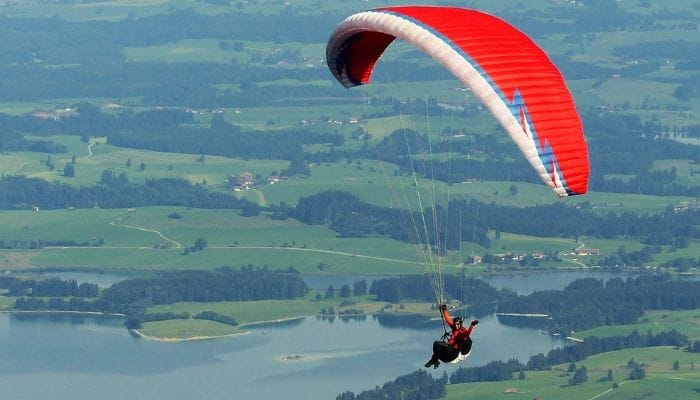
In the embrace of the Saputara hills, the Paragliding Festival soars as a testament to Gujarat’s adventurous spirit. Throughout December and January, for 26 festive days, thrill-seekers gather to sail the skies, gliding over breathtaking landscapes. Not just limited to the experienced, the festival offers training sessions, making it accessible to novices and ensuring that everyone can experience the joy of flight. It’s an exhilarating opportunity to witness Gujarat from a different vantage point—high above its rolling hills and verdant greenery, where the rush of the wind matches the excitement on the ground.
- When Paragliding Festival is Celebrated: Annually, for 26 days between December and January due to the collaboration between the Gujarat Tourism Department and other private organizations.
- Location: Saputara, Dang district.
- Best for: Adventure enthusiasts, thrill-seekers, nature lovers, and those eager to experience paragliding.
4. Vautha Mela
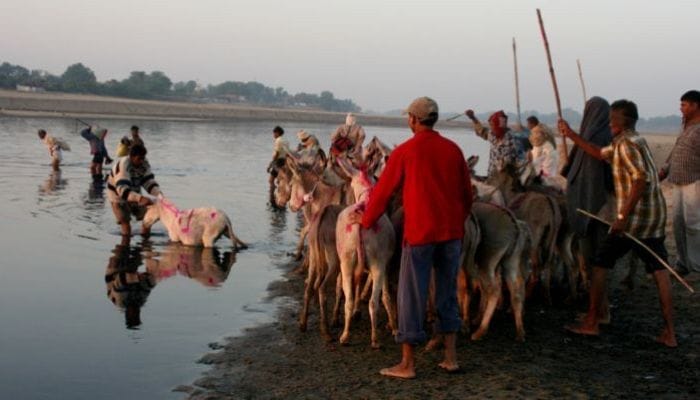 Image Source
Image SourceVautha Mela stands out evocatively in Gujarat’s festival calendar where the rural heart meets spiritual traditions at the confluence of seven sacred rivers during the full moon night of Kartik month. Recognized also for the notable animal trading, this five-day festival brings together a stunning assembly of camels and donkeys, ornately decorated to capture the imaginations of potential buyers in a vibrant trade fair.
Pilgrims and enthusiasts traverse the Runn of Kutch on camel carts, seamlessly blending wildlife with cultural fanfare. But it’s more than mere commerce, the fair garners a spiritual significance that eclipses even Diwali for many. As dusk falls, the river glimmers with the light of countless diyas, a sight of profound beauty and serenity, while the air fills with the aroma of local delicacies, making Vautha Mela a truly multisensory experience.
- When Vautha Mela is Celebrated: During the full moon night of Kartik month, around November
- Location: Vautha, where the Vatrak and Sabarmati rivers meet
- Best for: Traditional fair enthusiasts, animal lovers, and spiritual event explorers.
5. Tarnetar Fair
 Image Source
Image SourceThe Tarnetar Fair is an iconic traditional festival that encompasses the social fabric of rural Gujarat in its most vivid form. It mirrors the splendor of a wedding, bringing together communal joy and vibrant colors, much like the famous Madhavrai fair, which celebrates the divine union of Lord Krishna and Devi Rukmini. Renowned for its unique match-making aspect, where tribal communities gather in the pursuit of finding suitable spouses amid festivities similar to a handi ceremony, it offers a glimpse into local traditions and social practices.
Celebrated near the ancient Trinetreshwar Mahadev Temple, just as families flock to the Vautha fair venue, the Tarnetar Fair offers its grounds as a venue for connections and cultural exchange. It unfolds with a display of elaborate tribal attire, a collage of hand-embroidered textiles reminiscent of a vibrant bazaar, and the rhythmic beat of folk music. Spearheaded by the traditional ‘Swayamvara’ or the ritual of choosing one’s own spouse, this fair is a nod to epic heritage, dating back to Draupadi’s choice in Mahabharata. For those attending, the Tarnetar Fair presents an unparalleled peek into the cultural heartbeat of Gujarat, akin to stepping into a living, breathing bazaar of traditions.
- When Chitra Tarnetar Fair is Celebrated: End of August to early September
- Location: Tarnetar Village, near Thangadh in the Saurashtra region
- Best for: Cultural explorers, anthropology enthusiasts, and admirers of India’s rural festivities.
Religious and Seasonal Festivals in Gujarat
1. Bhavnath Mahadev Fair
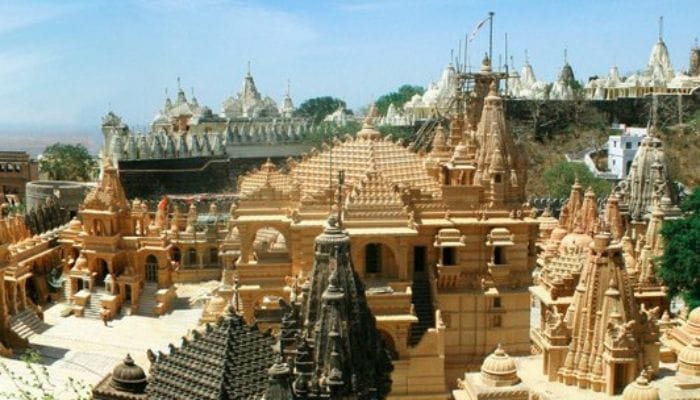 Image Source
Image SourceThe Bhavnath Mahadev Fair is a spiritually charged festival that embodies Gujarat’s devotion to Lord Shiva. The Bhavnath Mahadev Fair is a spiritually charged festival that embodies Gujarat’s devotion to Lord Shiva. Held at the Bhavnath Mahadev temple, a revered site near the Girnar hills, it celebrates the divine Hindu festival of Mahashivratri, typically in February or March. This five-day affair coincides with the auspicious Maha Shivratri, believed to be a time of divine presence when Lord Shiva himself visits the earth. Amidst the backdrop of the Girnar hills, the fair commences with the resonant sound of conch shells blown by sages perched atop decorated elephants.
Devotees from across the nation converge at the Junagadh’s Bhavnath Mahadev Temple to perform the rituals and partake in the electrifying parade. The fair is also known for its ‘Maha Prasad’ where visitors are offered free food, affirming the sense of community and equality synonymous with the festival. Alongside the spiritual activities, attendees can savor the cultural experience with vibrant food stalls which offer a taste of the local cuisine, thus blending devotion with culinary delights.
- When Bhavnath Mahadev Fair is Celebrated: Coincides with Mahashivratri in February or March
- Location: Bhavnath Mahadev Temple, Junagadh
- Best for: Spiritual travelers, cultural buffs, and explorers of authentic Indian festivities
2. Rath Yatra
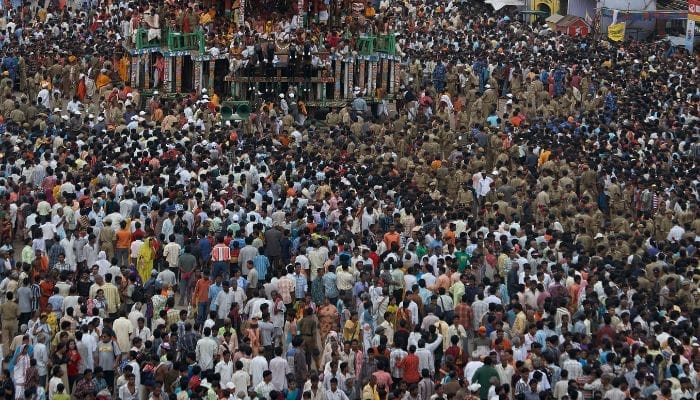
Rath Yatra strikes a divine chord within the hearts of devotees as they celebrate the grandeur and majesty of Lord Jagannath. In Gujarat, the Ahmedabad Rath Yatra is a festival of utmost importance, renowned for its vibrant procession that begins at the spectacular Jagannath Temple. This event in Ahmedabad is one of the most anticipated, echoing the jubilation of the original festival in Odisha. The celebration, occurring in either June or July, captivates with the elaborate chariots of Lord Jagannath, his brother Balabhadra, and sister Subhadra, which are magnificently adorned and pulled by a sea of believers.
It’s a powerful collective display of faith, where communal harmony shines as individuals from diverse backgrounds, including many devotees from Gujarat as well as Rajasthan, come together to partake in this renowned sacred ritual.
- When Rath Yatra is Celebrated: In June or July, during the monsoon season
- Location: Jagannath Temple in Ahmedabad, Gujarat
- Best For: Enthusiasts of religious traditions, cultural celebrations, and communal gatherings
3. Janmashtami

Janmashtami stands as a beacon of devotion, marking the birth of Lord Krishna with nighttime jubilation that resonates through the entire state. In Gujarat, the grandiloquence of this festival reaches its zenith in Dwarka, believed to be Lord Krishna’s own kingdom. The festival unravels with devotees fasting, singing devotional songs, and the air smells of incense and flowers as temples are decked for the occasion. When the clock strikes midnight—the moment of Krishna’s birth—priests perform the ‘maha-abhishek’, anointing the idol with sacred substances, followed by its adornment in new clothes and jewels.
The ritual vibrates through the crowd as they break their fast and engage in ‘dahi-handi’ festivities, replicating Krishna’s playful butter heist. To stay updated on such auspicious occasions and the vibrant celebrations that follow, subscribing to a culturally rich newsletter can enhance one’s connection to the festivities and offer insights into the devout practices across the globe.
- When Janmashtami is Celebrated: Typically in August or September, following the lunar calendar.
- Location: Across Gujarat, with special exuberance in Dwarka.
- Best for: Devotees of Lord Krishna, cultural enthusiasts, families, and travelers interested in India’s spiritual and cultural festivities.
4. Bhadrapurnima Fair
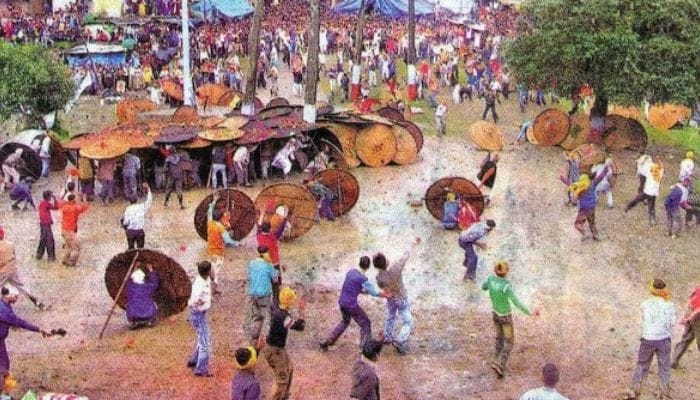 Image Source
Image SourceThe Bhadrapurnima Fair, or Bhadra Purnima, enamors visitors not only with its religious sanctity but also its cultural fervor. Held at the revered Ambaji Temple in Banaskantha during the full moon of Bhadrapad, agriculture enthusiasts eagerly attend, seeking blessings for a fruitful harvest season. The goddess Ambaji is worshipped without an idol, instead, adoration is directed to a richly inscribed ‘Vishwa Yantra’, symbolizing the deity. Evening times are illuminated by the enchanting folk performances of Bhavai and Garba, encapsulating the jubilant essence of Gujarat. The unique combination of devotion and celebrations on September 18th, 2024, will offer an extraordinary experience to all present.
- When Bhadrapurnima Fair is Celebrated: Full moon day in September (Bhadrapad)
- Location: Ambaji Temple, Banaskantha district, Gujarat
- Best for: Pilgrims, cultural enthusiasts, visitors seeking a blend of spirituality and festivity
5. Navratri
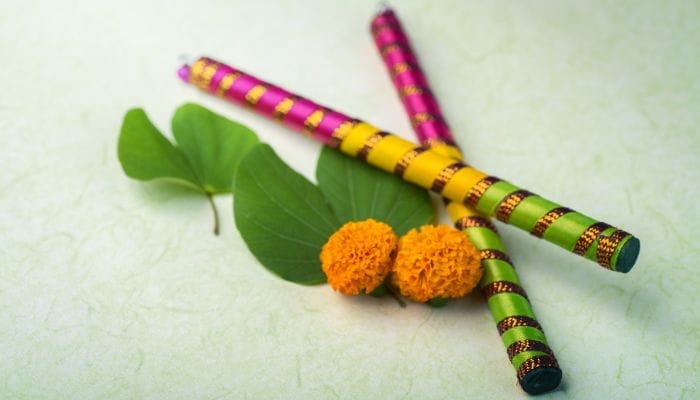
Navratri, undoubtedly the jewel in the crown of Gujarat’s festivals, honors the divine feminine with fervent energy that ripples across nine nights of dance, music, and religious observances. Typically held in September or October, this festival sees entire communities come alive after sunset with the rhythmic beats of Garba and Dandiya Raas, as they swirl in synchrony paying homage to Goddess Durga and her avatars. Moving beyond the dance, the festival’s spirit extends to vibrant flea markets, where locals and visitors alike marvel at handicraft stalls, each aglow with brass ornaments and glimmering silverware.
Traditional attire like the vibrant Ghagra-Choli and Kediyu becomes a feast for the eyes while the air is filled with the sounds of folk melodies and the scent of jasmine. Each night resonates with spirituality and celebration as Gujarat showcases its cultural tapestry in the most elaborate fashion, complete with stalls laden with unique copper utensils and a panoply of ornamented items befitting the festival’s grandeur.
- When Navratri is Celebrated: September or October
- Location: Throughout Gujarat, especially Vadodara and Ahmedabad
- Best for: Cultural enthusiasts, dance lovers, foodies
6. Holi
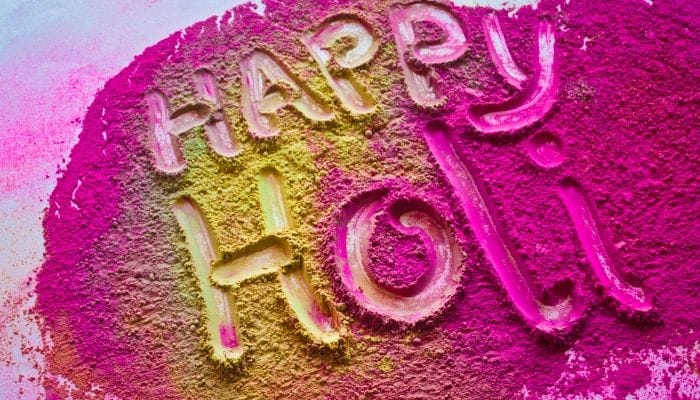
In Gujarat, Holi bursts forth as a joyous expression of life and a vivid commemoration of good triumphing over evil. Renowned for the ‘Holika Dahan’, the spectacle where effigies are burned symbolizing the destruction of demonic forces, the festival brings together communities in a show of unity and festivity. The air on the following day, ‘Dhuleti’, is a carnival of colors where everyone, regardless of age or social stature, engages in playful abandon, smearing each other with vibrant powders and drenching in colored waters. Traditional treats like ‘Puran Poli’ and ‘Thandai’ blend with the sounds of laughter creating an ambiance of merry-making that encapsulates the welcoming and inclusive spirit of Gujarat.
- When Holi is Celebrated: Holi is celebrated on the full moon day in the month of Phalguna, which falls between late February and early March in the Gregorian calendar.
- Location: Holi is celebrated across India, with major celebrations in cities like Mathura, Vrindavan, Delhi, Jaipur, and Varanasi.
- Best For: Holi is best for people who enjoy vibrant and energetic festivities, cultural experiences, and socializing, as it involves singing, dancing, and the playful throwing of colors.
7. Diwali

Diwali, the festival of lights, is Gujarat at its brightest, enveloping the state in a warm glow of jubilation. Symbolizing the triumph of light over darkness and knowledge over ignorance, homes across Gujarat radiate with the soft flicker of diyas, the vibrant colors of shimmering rangolis, and the festive glimmer of string lights, creating an atmosphere brimming with cheer. In the background, the symphony of firecrackers resounds in the skies, blending perfectly with the harmony of family gatherings. During these celebrations.
Relatives exchange not only gifts and sweets but also hearty wishes for the Gujarati New Year. This festive period, overlapping with the jubilant harvest festival, sees homes open their doors to extended family and friends, sharing traditional treats like ‘chakli’ and ‘murukku’. The air is thick with the sound of ‘Sal Mubarak’ greetings, an echo of the collective aspiration for a future filled with hope and prosperity.
- When Diwali is Celebrated: Diwali, also known as the Festival of Lights, is celebrated over five days, with the main day of festivities occurring on the new moon night of the Hindu lunisolar month Kartika, which typically falls between October and November.
- Location: Diwali is celebrated throughout India and in many other countries with significant Hindu populations. Major celebrations take place in cities like Delhi, Mumbai, Jaipur, Kolkata, and Ayodhya.
- Best For: Diwali is best for those who enjoy cultural and religious celebrations, family gatherings, and festive activities such as lighting lamps, fireworks, feasting, and exchanging
8. Bhadrapad Ambaji Fair
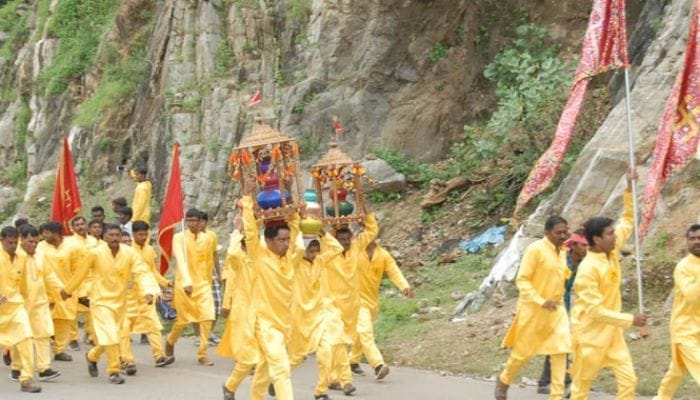 Image Source
Image SourceThe Bhadrapad Ambaji Fair, also known as the Ambaji Mela, is a confluence of piety and cultural extravaganza geared towards the worship of Goddess Amba at the Ambaji Temple. During the Bhadrapad month, pilgrims are immersed in the divine chant of ‘Saptashati’ – the seven hundred verses in praise of the goddess. This time-honored tradition is supplemented by the folk dances of Garba and Bhavai that enthrall the audience as the sun set. Held in the serene town of Ambaji in Banaskantha, this festival binds the community in religious observance and resonates with the sounds of devotion and merriment late into the night.
- When Bhadrapad Ambaji Fair is Celebrated: The Bhadrapad Ambaji Fair is celebrated during the month of Bhadrapad, which falls in August or September, depending on the lunar calendar.
- Location: The fair takes place in Ambaji, a town located in the Banaskantha district of Gujarat, India, near the Rajasthan border.
- Best For: This festival is best for experiencing vibrant cultural traditions, participating in devotional activities, and witnessing the grand procession to the Ambaji Temple, one of the 51 Shakti Peethas in Hindu mythology.
9. Muharram
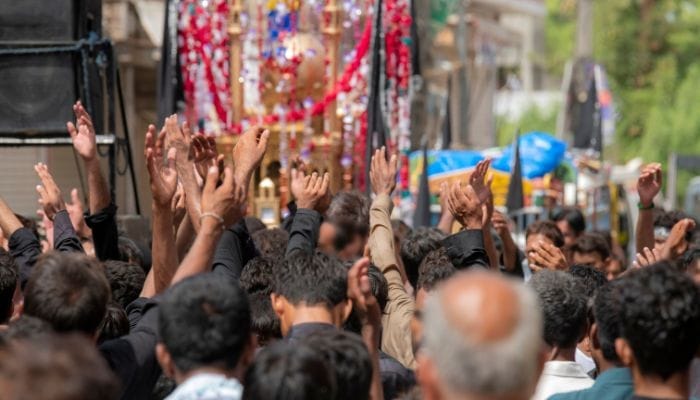
Muharram in Gujarat encapsulates the essence of reflection and reverence, as it stands out in communal harmony. Muharram in Gujarat encapsulates the essence of reflection and reverence, as it stands out in communal harmony. It signifies the Islamic New Year, marking a period of mourning for the martyrdom of Husayn ibn Ali, the grandson of Prophet Muhammad, at the Battle of Karbala. The solemnity of Muharram is characterized by processions (Matam) through the streets, with individuals rhythmically beating their chests in grief and chanting elegies.
Moreover, the commemorative events are openly accessible, allowing for a wider awareness that could be shared via a website or through browser updates to ensure respectful participation. In unison, communities partake in this sober commemoration, which transcends religious identities, reflecting the syncretic culture of Gujarat where mutual respect for rituals is a binding thread of societal fabric.
- When Muharram is Celebrated: Muharram is observed during the first month of the Islamic lunar calendar, with Ashura on the 10th day.
- Location: Muharram is observed worldwide, with notable commemorations in Iraq, Iran, India, Pakistan, Lebanon, and Bahrain.
- Best For: Understanding Islamic history, particularly the martyrdom of Imam Hussein, through processions, lamentations, and reenactments.
Cultural Festivals That Celebrate Traditions
1. Rann Utsav

The Rann Utsav is a celebration of the myriad facets of Gujarat’s desert life, artistry, and tradition sprawling across the surreal white landscape of the Kutch region. As with the Rann Utsav, so does the spirit of celebration manifest through the much-anticipated beach festival, which typically takes place between November and December. This coastal counterpart to the desert fiesta also features a vibrant showcase of arts and performances, specifically held at the famous Tithal Beach of Gujarat. Here, visitors can expect a similar atmosphere of culture and revelry, with the added charm of the beach’s soothing sands and picturesque sunsets, festooned with lights and the energizing ambiance of live shows.
The Rann Utsav captivates visitors from November to February, transforming the salt marsh into a tapestry of folk dances, music, and vibrant Kutchi crafts. As night descends, the moonlight bathes the white desert, turning it into a mystical expanse, perfect for meditative walks or full-moon photography. Luxurious tents offer a comfortable stay, while camel safaris and cultural performances enrich the diversity of experiences that hallmark the Rann Utsav alongside the beach festival, both affirming Gujarat’s rich cultural tapestry.
- When Rann Utsav is Celebrated: Usually from October or November to February
- Location: Rann of Kutch, Gujarat
- Best for: Cultural enthusiasts, photographers, families, and nature lovers
2. Kavant Fair
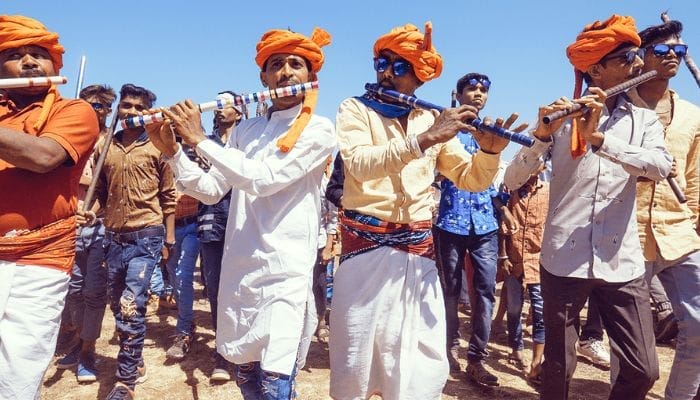 Image Source
Image SourceThe Kavant Fair epitomizes the sheer vibrancy of tribal celebrations in Gujarat’s cultural milieu, deeply ingrained in the local ethos of the tribal regions. Typically held after Holi, it marvels spectators with its exceptional human pyramid games and the striking visual feast of performers adorned with hues made of rice and ash. The festival is not just a display of athleticism and artistry but also a testament to the community’s synergy and spirit. As each tribe showcases its unique customs through music and dance, visitors are treated to an authentic slice of Gujarat’s rich tribal heritage.
- When Kavant Fair is Celebrated: After the Holi festival, typically in March
- Location: Tribal areas of Gujarat, predominantly in Chhota Udepur district
- Best for: Cultural adventurers, ethnographers, artists, and global culture enthusiasts
3. Chitra Vichitra Mela
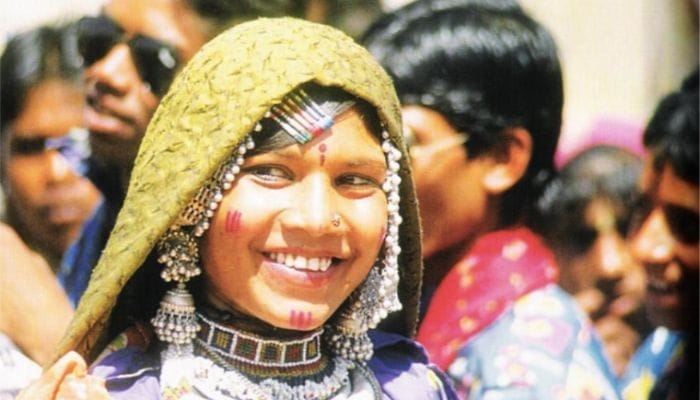 Image Source
Image SourceThe Chitra Vichitra Mela vibrates with the solemn tunes of a unique cultural ritual held on the eve of the new moon. It is the largest tribal fair where locals, especially women, gather by the rivulets of the Wakal River to mourn for their departed loved ones, fostering a sense of collective solace. Following this nocturnal remembrance, the break of dawn welcomes vibrant celebrations, with men donning saffron turbans and the pulsating rhythms of folk songs. With a blend of somber reflection and ebullient festivities, the fair opens up windows to the ancient traditions and the heartwarming solidarity of Gujarat’s tribal communities.
- When Chitra Vichitra Mela is Celebrated: The eve of the new moon, usually in March or April.
- Location: Near the confluence of three rivers in the Sabarkantha district.
- Best for: Social anthropologists, cultural enthusiasts, and travelers interested in tribal traditions.
4. Madhavrai Fair
 Image Source
Image SourceThe Madhavrai Fair, held in the picturesque village of Madhavpur near Porbandar, reverberates with historical and spiritual narratives, celebrating the celestial marriage of Lord Krishna and Devi Rukmini. Synonymous with Gujarat’s cultural spirit, this event during March or April heralds springs with theatrical enactments, traditional folk dances, and music that resonates with devotional exhilaration. Villagers and visitors alike congregate to witness the grand procession representing the divine nuptials, an event central to the fair’s charm. The fair is a splendid opportunity to glimpse into the ethereal tapestry of devotion, community participation, and cultural pride.
- When Madhavrai Fair is Celebrated: During the Chaitra month of the Hindu calendar, typically observed in March or April.
- Location: The fair unfurls in the serene Madhavpur Village, nestled near Porbandar.
- Best For: Enthusiasts of mythological narratives, traditional festival aficionados, and families desiring a spiritually and culturally rich experience.
5. Ravechi Fair
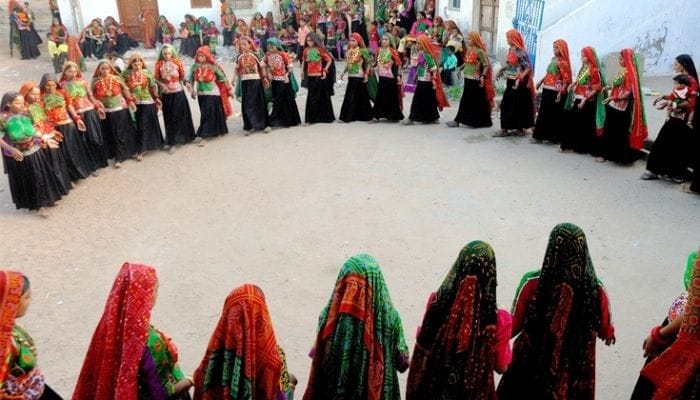 Image Source
Image SourceThe allure of the stark white salt desert of Kutch elevates during the Ravechi Fair, merging spirituality with the colorful traditions of Gujarati culture. Celebrated in September, the fair magnetizes pilgrims and art enthusiasts alike for a communal experience of vibrant devotion. Over two days, the fair is aglow with cultural dances, folk songs, and exhibits that vivify the rich tapestry of the local lifestyle. Art workshops and exhibitions provide an exceptional window into the core of Gujarati tradition, making the Ravechi Fair a celebrated marker of cultural identity and continuation in the region.
- When Chitra Ravechi Fair is Celebrated: September
- Location: Ravechi Temple, Kutch
- Best for: Art and craft enthusiasts, culture-seeking travelers, spiritual visitors
6. Shamlaji Melo
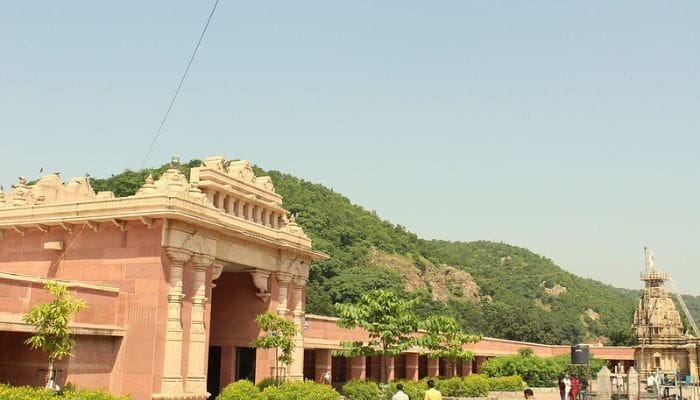 Image Source
Image SourceSituated near the revered Shamlaji Temple on the banks of the mesmerizing Meshwo river, Shamlaji Melo or the Kartik Purnima Fair is not only a spiritual high point but also a vibrant display of Gujarat’s tribal culture. Taking place around November on the auspicious day of Karthik Purnima, it draws over two lakh visitors including the ‘Garasiya’ community, who play a central role in the festivities. Devotees often undertake long pilgrimages on foot or by camel, symbolizing their enduring faith.
The air resounds with folk songs as attendees in traditional attire engage in dance and mirth. The fair also serves as a bustling marketplace offering an array of traditional crafts, intricate silver jewelry, and ethnic cloth, making it a haven for those who cherish authentic cultural experiences.
- When the Shamlaji Melo is Celebrated: November, during the *full moon of Kartik month*
- Location: Shamlaji Temple, *banks of Meshwo River, Aravalli District*
- Best for: *Spiritually inclined visitors*, cultural tradition enthusiasts, and anyone seeking a traditional Indian festival.
Most of Your Visit During Festivals in Gujarat
Planning Your Itinerary Around the Festivals
To truly capture the essence of Gujarat’s festivities, meticulous planning is paramount. Timing your visit to align with the grandeur of a specific festival can significantly enhance your travel experience. Consider the festival dates, often determined by the lunar calendar, and plan to arrive a few days in advance to immer archaeology archaeological excursions, and know the locale. Ensure accommodations are booked well in advance, as places like Bhuj during the Rann Utsav or Ahmedabad during Navratri become hotspots attracting millions. Craft an itinerary that blends the festival’s highlights with periods of downtime to reflect and rest, ensuring a balanced and enriching journey through Gujarat’s cultural heartbeat.
What to Include:
- Research Festival Dates: Check the lunar calendar as many festivals are scheduled accordingly, including Gujarat’s illustrious Kite Festival or Diwali. Keep an eye on the festival’s official website or subscribe to their newsletter for the most accurate dates and additional festivities information.
- Accommodation: Book well in advance, especially if you’re attending the more popular festivals like Navratri or Rann Utsav – both are major attractions in the region. Remember to clear your browser cookies for potentially better rates on hotel and lodging websites.
- Travel Options: Consider the transportation available, as this travel destination offers a multitude of options between cities and to festival locations, which may be in remote areas.
- Local Guides: Engaging a local guide not only supports the local economy but also significantly enhances your understanding and enjoyment of the festivals.
- Allow Downtime: Ensure that your itinerary isn’t too packed, allowing you to fully absorb and relish each event.
Best Time to Visit During Festivals in Gujarat
The best time to experience Gujarat’s festivals is from September to March when the climate is pleasant and conducive to outdoor activities. This period is speckled with numerous prominent festivals such as Navratri in September or October, the International Kite Festival in January, and the Rann Utsav from November to February. Each festival summons a different facet of Gujarati culture, so choose the one that aligns with your interests, whether it’s the traditional dance forms during Navratri or the desert culture at the Rann Utsav. Planning around these events ensures not only comfortable weather but also a priceless glimpse into the state’s living heritage.
| Festival | Month | Description |
| Navratri | September/October | Nine-night festival of dance and devotion, celebrating Goddess Durga with Garba and Dandiya. |
| Diwali | October/November | Festival of lights, marking the victory of light over darkness with lamps, fireworks, and sweets. |
| Uttarayan (Kite Festival) | January | Celebration of Makar Sankranti with vibrant kite flying, marking the transition of the sun. |
| Rann Utsav | November to February | Cultural festival in the Rann of Kutch, featuring crafts, music, dance, and traditional cuisine. |
| Janmashtami | August | Celebration of Lord Krishna’s birth with devotional songs, dances, and rituals. |
| Rath Yatra | June/July | Chariot festival in Ahmedabad, where idols of deities are paraded through the streets. |
| Holi | March | Festival of colors, celebrating the arrival of spring with vibrant powder and water play. |
| Bhadrapurnima Fair | September | Religious fair held in honor of Goddess Ambaji, featuring traditional rituals and celebrations. |
| Bhavnath Mahadev Fair | February/March | Religious fair at Bhavnath Mahadev Temple, featuring Hindu rituals and cultural performances. |
| Muharram | September/October | Islamic festival of mourning, observed with processions and unique rituals. |
Tips for Immersive Experience in the Gujarati Culture
For travelers seeking an authentic and enriching cultural experience in Gujarat, immersion is key. Here are some tips to help you dive deep into the festivities and traditions:
- Participate Actively: Join in the Garba dance during Navratri or try flying a kite at Uttarayan. Active participation helps you connect with the locals and the essence of the festival.
- Local Attire: Dress in traditional Gujarati clothes such as a ‘Ghagra-Choli’ or ‘Kedia’ to blend in and experience the festivities firsthand.
- Learn a Few Phrases: Knowing basic Gujarati phrases like “Kem cho?” (How are you?) can be a delightful ice-breaker.
- Savor the Cuisine: Relish local dishes like ‘Dhokla’, ‘Khandvi’, or ‘Thepla’. Indulging in local cuisine offers insights into the region’s cultural palette.
- Respect the Traditions: Every festival has its customs. Show respect, and be observant of local etiquette and religious rituals.
- Capture Memories: Take photographs or keep a journal, but also make sure to sometimes put the camera away and be present in the moment.
By looking beyond that of an ordinary tourist to that of an eager learner, you’ll find yourself enveloped in the warmth of Gujarati culture.
Exploring the Culture, Traditions, and Nature of Gujarat
Discover the vibrant culture and diverse attractions of Gujarat through a variety of activities. From exploring historical sites to enjoying traditional festivals, there is something for everyone. For more details, check out Things to Do in Gujarat.
The traditional attire of Gujarat reflects its rich cultural heritage and vibrant lifestyle. From the colorful chaniya choli worn by women to the elegant kediyu worn by men, each garment tells a story. Learn more about the fascinating Traditional Dress of Gujarat.
Gujarat is home to some of India’s most spectacular wildlife sanctuaries, offering a haven for nature lovers. These sanctuaries provide a glimpse into the state’s diverse flora and fauna. Explore the best Wildlife Sanctuaries in Gujarat for an unforgettable adventure.
Gujarat is home to numerous significant temples that showcase its rich cultural and spiritual heritage. For more detailed information on these sites, you can visit this list of famous temples in Gujarat, which highlights their historical and religious importance.
FAQs About Experiencing Festivals in Gujarat
When is the best time to visit Gujarat for festivals?
The best time to visit Gujarat for festivals is during the winter months, from October to February, when major festivals like Navratri, Diwali, and Uttarayan are celebrated.
What Should Visitors Know Before Attending Gujarat Festivals?
Before attending Gujarat festivals, visitors should be aware of the cultural significance and dress codes of each event. Research the dates as they often change yearly following the lunar calendar. Understand the customs, such as removing shoes before entering temples during Janmashtami, or the significance of fasting during Navratri. Acquaint yourself with local norms to respect the traditions, and be prepared for large crowds. Lastly, book accommodations in advance as festivals attract a high number of tourists.
How Can Tourists Participate in the Festivities?
Tourists can participate in the festivities by engaging in various activities integral to each festival. During Navratri, join in the Garba dances, for Uttarayan, partake in kite flying activities, and, at the Rann Utsav, explore the desert culture through camel rides and folk performances. Many festivals also encourage visitors to sample traditional foods, shop for local handicrafts, and witness religious ceremonies. Familiarize yourself with the festival rituals and express openness and respect for the local customs to enjoy a fully immersive experience.
What should I wear when attending festivals in Gujarat?
It’s best to wear comfortable and traditional attire. For Navratri, women often wear chaniya choli, and men wear kediyu. During other, traditional Indian clothing like sarees and kurtas are appropriate.
Which festival is most important and famous in Gujarat?
In the kaleidoscope of Gujarat’s festivities, Navratri stands as the most significant and famous festival, deeply entrenched in the state’s identity. It’s an exhilarating celebration distinguished by its signature folk dance, the Garba, which encapsulates the vibrant cultural and spiritual life of Gujarat. The Rann Utsav is also immensely popular, drawing visitors to the spectacular white salt desert for a cultural extravaganza that displays the unique heritage of the Kutch region. Both festivals have their own charm, with Navratri embodying the zest of Gujarati tradition and the Rann Utsav showcasing the region’s natural and cultural splendors.
Final Remarks
As we conclude, it’s evident that Gujarat are not just annual events but are interwoven with the state’s identity, showcasing the exuberant culture and profound traditions of its people. These festivities offer a window into the soul of Gujarat where history, myth, and modernity dance hand in hand. For those seeking an indelible experience, engaging with these celebrations promises memories that will resonate long after the music fades and the lights dim. Embrace Gujarat’s festive spirit, and you might just leave with a piece of its heart, inextricably linked to the beats of its Garba, the flight of its kites, or the tranquility of its moonlit deserts.


I do not know.
Give a round of applause in the comments to show your appreciation!
Are you sure you’re ready to see this?
Access restricted to 18+
Penetrate
Are you sure you’re ready to see this?
Access restricted to 18+
Penetrate
Are you sure you’re ready to see this?
Access restricted to 18+
Penetrate